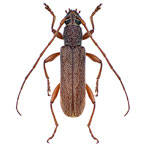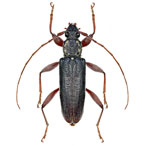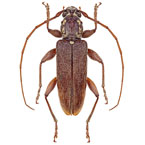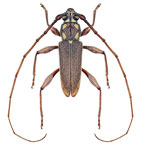Ceresium
Newman
Cerambycinae
Ceresium Newman, 1842b: 322. Type species: Ceresium raripilum Newman, 1842.
Diagnosis
Small to medium-sized brown beetles with filiform antennae slightly extending beyond apices of elytra. Frontoclypeus transverse or subquadrate, inclined. Eyes coarsely facetted and deeply emarginate. Antennal insertions separated apically and removed from mandibular articulation. Antennal foramen depressed. Antennal scape gradually expanded toward apex, distinctly shorter than pronotum; pedicel transverse; antennomere 3 as long as scape, without apical spine; antennomeres 3–7 without spines. Pronotum as long as wide, lateral margins smooth; pronotal disc flat, without tubercles often bearing patches of white depressed setae. Prosternal process narrow, slightly expanding apically. Procoxal cavities rounded without lateral extensions; open externally. Procoxae projecting below prosternal process. Mesoventrite flat in front of coxae; mesoventral intercoxal process moderately broad, emarginate apically, with secondary articulation. Mesocoxal cavities closed to mesepimeron; mesotrochantin not visible. Elytral punctures not in rows; elytron without costae. Meso- and metafemora broadest near middle femora without ventral setose brushes; tibiae not flattened.
Distribution and Biology
Ceresium is distributed predominantly in northern and eastern parts of Australia. Several species are known from Lord Howe, Norfolk and Christmas Islands. Ceresium is a large genus with 130 species known, distributed in the Oriental and Papuan regions, Australia, Fiji and New Zealand. Ceresium flavipes (Fabricius) has been introduced into the Old and New World tropics.
In tropical and subtropical parts of Australia they are collected year round, attracted to lights, beaten from vegetation or collected in Malaise and flight intercept traps.
Australian Species
affine (Gahan)
Examnes affinis Gahan, 1900: 122.
annulicorne (Germar)
Stenocorus annulicornis Germar, 1848: 226.
flavipes (Fabricius)
Callidium flavipes Fabricius, 1792: 327.
Stenochorus simplex Gyllenhal, 1817: 178.
Arhopalus ambiguus Newman, 1842a: 246.
kimberley Ślipiński & Escalona
Ceresium affine Aurivillius, 1917: 12 nec Gahan, 1900.
lineigerum Pascoe
Ceresium lineigerum Pascoe, 1888: 493.
minor (Blackburn)
Strongylurus minor Blackburn, 1894: 199.
mjoebergi Aurivillius
Ceresium mjoebergi Aurivillius, 1917: 11.
nigrum Gahan
Ceresium nigrum Gahan, 1888: 540.
pachymerum (Pascoe)
Diatomocephala pachymera Pascoe, 1869: 542.
Ceresium validipes Fairmaire, 1883: 46.
quadrimaculatum Gahan
Ceresium quadrimaculatum Gahan, 1900: 121.
raripilum Newman
Ceresium raripilum Newman, 1842b: 322.
seminigrum Aurivillius
Ceresium seminigrum Aurivillius, 1917: 11.
simplex (White)
Oemona simplex White, 1855: 331.
Ceresium procerum Olliff, 1890: 74.
vile (Newman)
Callidium vile Newman, 1841: 223.
References
Aurivillius, C. 1917. Results of Dr E, Mjöberg's Swedish scientific expeditions to Australia 1910–1913. 12, Cerambycidae. Arkiv för Zoologi 10(23): 1–50 pls 1–3.
Blackburn, T. 1894. Notes on Australian Coleoptera with descriptions of new species. Part XIII. Proceedings of the Linnean Society of New South Wales 2 8: 185&208.
Fabricius, J.C. 1792. Entomologia Systematica Emendata et Aucta. Secundum, Classes, Ordines, Genera, Species, adjectis synonimis [sic], locis, observationibus, descriptionibus. Hafniae : Christ. Gottl. Proft. Vol. 1(1) xx 330 pp.
Fairmaire, L. 1883. Essai sur les Coléoptères de l’Archipel de la Nouvelle-Bretagne. Annales de la Société Entomologique de Belgique 27(2): 1–58.
Gahan, C.J. 1888. On the Coleoptera of Christmas Island. Proceedings of the Scientific Meetings of the Zoological Society of London 1888(4): 538–541.
Gahan, C.J. in Waterhouse, C.O., Gahan, C.J. & Arrow, G.J. 1900. Order 4.-Coleoptera. New species descriptions. pp. 89–127 in Andrews, C.W. (ed.). A Monograph of Christmas Island (Indian Ocean): physical features and geology; with descriptions of the fauna and flora by numerous contributors. London : British Museum (Natural History) xiii 337 pp.
Germar, E.F. 1848. Beiträge zur Insektenfauna von Adelaide. Linnaea Entomologica 3: 153–247.
Gyllenhal, L. 1817. Sistens descriptiones novarum specierum. pp. 1–144, Tab. 5 & 6 in Schönherr, C. J. (ed.). Appendix ad C. J. Schönherr Synonymiam Insectorum. Scaris : Lewerentziana Vol. I(3) 266 pp.
Newman, E. 1841. Entomological notes (continued). The Entomologist 1(14): 220–223.
Newman, E. 1842a. Cerambycitum Insularum Manillarum Dom. Cuming captorum enumeratio digesta. The Entomologist 1(15): 243–248.
Newman, E. 1842b. Cerambycitum Insularum Manillarum D. Cuming captorum enumeratio digesta (continued). The Entomologist 1(20): 318–324.
Olliff, A.S. 1890. Additions to the insect-fauna of Lord Howe Isaland, and descriptions of two new Australian Coleoptera. Records of the Australian Museum, Vol. 1 72–76.
Pascoe, F.P. 1869. Longicornia Malayana (continued). Transactions of the Entomological Society of London 3 3(6): 497–552.
Pascoe, F.P. 1888. On some new longicorn Coleoptera. Transactions of the Entomological Society of London 1888(4): 491–513 pl. xiv.
White, A. 1855. Catalogue of Coleopterous Insects in the Collection of the British Museum. Part viii. Longicornia II. London : British Museum iii 175–409 pls v–x.



